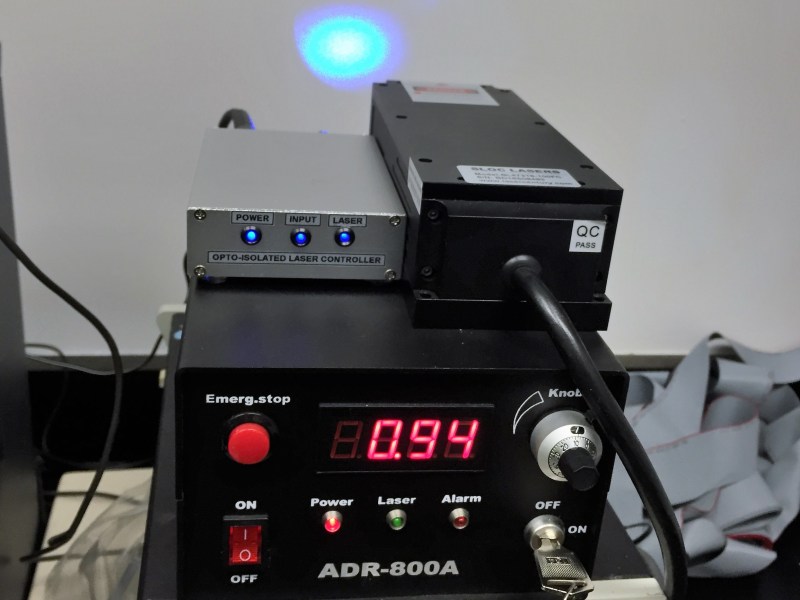
[Scott Harden] is working on a research project involving optogenetics. From what we were able to piece together optogenetics is like this: someone genetically modifies a mouse to have cell behaviors which can activated by light sensitive proteins. The mice then have a frikin’ lasers mounted on their heads, but pointing inwards towards their brains not out towards Mr. Bond’s.
Naturally, to make any guesses about the resulting output behavior from the mouse the input light has to be very controlled and exact. [Scott] had a laser and he had a driver, but he didn’t have a controller to fire the pulses. To make things more difficult, the research was already underway and the controller had to be built
The expensive laser driver had a bizarre output of maybe positive 28 volts or, perhaps, negative 28 volts… at eight amps. It was an industry standard in a very small industry. He didn’t have a really good way to measure or verify this without either destroying his measuring equipment or the laser driver. So he decided to just build a voltage-agnostic input on his controller. As a bonus the opto-isolated input would protect the expensive controller.
![The kind of travesty that can occur when [Stefan Kiese] doesn't have access to nice project boxes.](https://hackaday.com/wp-content/uploads/2016/07/img_3466.jpg?w=250)
He packaged everything in a nice project box. He keeps them on hand to prevent him from building circuits on whatever he can find. Adding some tricks from the ham-radio hobby made the box look very professional. He was pleased and surprised to find that the box worked on his first try.















Hey [Scott Harden], almost there with the case…
http://hackaday.com/2016/06/05/a-cake-tin-makes-a-great-tube-amp-chassis/
Oh NO!!! Little Johnie CircuitMaker has gotten into the cupboards again.
Just jokes, I love it. Raw and delightful at the same time.
depending on frequency of the pulses the power of the laser will not be linear, as the thing has at least two temperature regulations and maybe a beam pickoff for power regulation
better use an AOM for generating those pulses
also the laser seems a bit overrated to be fed to living tissues, but that’s my two cents… not talking about the animal cruelty behind all this…
I don’t think the 8 amps are compulsory, I’m sure his opto-coupler can just take less.
I dunno why it’s 100-odd watts, doesn’t seem likely to drive the tube, since gas lasers are high voltage. Maybe it drove a really really big relay or something. When you take the 8 amps away this gets a lot less dramatic. Would have been more interesting to see the actual mice / lasers, rather than a driver box with no details and a nice case.
Still, have to be impressed by the big emergency stop button, on a gadget for firing lasers into mice.
But I’m disappointed that the key operated switch doesn’t say arm and disarm instead of on and off, and that there aren’t two of them with code wheels, separated across the lab, such that Dr Evil can direct his trusted lieutenants to enable the device with their own key and codes, but neither one can turn it on his master by himself…
that’s a DPSS mate… most probably a 457nm unit of up to two watts, not a tube
beam profile, if no lens, suggests the head is way off alignment but the head seems sturdy and the beam is still gaussian which seems that the construction is quite nice, but the driver says completely otherwise… emergency shutdown not reliable (smash it and the whole laser fells down the table blinding all lab people) and general frontend seems poor chinese design
a cheap crystalaser unit from ebay may have provided better control and sturdiness for 200 bucks
a gas laser tube fot those wavelengths goes from a shoebox (ALC60x type) to a meter long tube with 400VDC 60A (innova type or SP10xx series)
DPSS, so the power is driving a load of diode lasers in series-parallel? That’s a powerful laser.
I think the article’s a bit confusing, since the laser he’s driving is a bit big to strap to a mouse’s head. I was expecting the laser driver to be something for that, presumably a little laser diode on the head. But then there’s this great big multi-hundred watt thing, looks like it’d vapourise the mouse.
Doesn’t seem to be a very good idea to have indicator LEDs the same color as the laser – when you’re wearing the safety goggles that block the wavelenght.
Lol, that is another not to use blue LEDs!
28vdc is very common in aircraft.
And in trucks and other heavy vehicles. 2x 14.4 Volts = 28.8 V which is the upkeep voltage of the alternator. In lower temperatures it may go up to 29.4V but generally 28 is what you’d expect to get out of a vehicle, after a suitable filter capacitor, with a 24 Volt power system when the engine is running.
24/28V isn’t really all that common in auto usage, but it used to be in tractors / semi trucks. Kenworth offered a 12/24 volt system that kept the batteries in parallel at 12V most of the time, but would series them to feed 24V to the starter motor. This was mainly meant as an aid for use in cold climates.
Some bus / coach-makers used 24V too.
+24v is also common in telecom, though -48 is also quite common.
>The logo for the field is kind of cute though.
That’s not anything near cute, that’s animal torture!
I am more upset I think that I’m now going to have search strings like…
“optical” “mouse” “hack” -optogenetics -neural -biology -proteins
Hahaha! I have the same problems.
-buy -ebay -appstore
Colbourn Hardware is a nightmare. The -27 V are a terrible choice.
Yet, since I’m doing the same experiments, triggering the laser directly us very bad. The crystal in it heats up and hence the pulses become stronger over time.
DPSS lasers should always be shuttered for reproducibility! Check SRS 475 for this task! Even allows full programming of the pulse pattern.